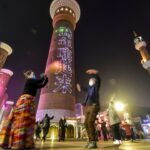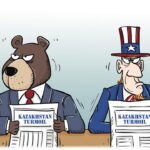Since the beginning of 2022, Kazakhstan has become the top newsmaker internationally. Worrisome events settled over the former Kazakhstani capital of Almaty after organized groups of rebels attacked government buildings, police stations, and even the Kazakh National Security Committee’s Almaty branch building in broad daylight in early January.
Stability in Kazakhstan has been undermined by several factors, most of which were related to natural rent distribution, internal political development and geopolitics. It looks like “a bowl of well-mixed noodles.”
Kazakhstan has avoided turning into one of the most dangerous places on the planet thanks to the decisive actions taken by Kazakhstani President Kassym-Jomart Tokayev.
Kazakhstan sits between Russia and China with Iran, Azerbaijan, Kyrgyzstan, Uzbekistan, and Turkmenistan to the south. The chaos in Kazakhstan would have a direct effect on all of these countries. Offshoots of chaos will be experienced at the international level. The largest ramifications will be in Ukraine and Syria.
Against this backdrop, Russia would be gripped by pliers of chaos, and China and some Central Asian countries would face threats of chaos on their own doorsteps. What happened in Kazakhstan could be the first stage of chaos intervention into the Central Asian nations. The inner values of humanities are blocked by crossing the “red line”: the Kazakhs were reported to have beat, knifed and shot each other.
The situation in Kazakhstan has been put under control. After that, several weeks will be spent to finally stabilize the political and social situation in Kazakhstan. The ruined buildings will be restored, but the ruined hearts will keep pain. But united people with sound ambitions and a wise president could endure the pain together.
Meanwhile, we should learn from these woeful lessons. Newly appointed State Secretary Erlan Karin said on Monday, “I think we encountered a hybrid terrorist attack on Kazakhstan that, as its end goal, sought general destabilization and possibly a coup.” He believed the previous scenario of “color revolutions” in relation to Kazakhstan would be ineffective. He said the unrest represented a “conspiracy of internal and certain external forces” as the terrorists included Kazakh and foreign nationals.
So, Kazakhstan faces a new type of so-called color revolution – more aggressive, more organized and with more human casualties. It could be better described as a “rebellious war.” President Tokayev has described the deadly violence taking place last week as an attempted coup d’etat.
The new scenario has the following stages. After the mainly peaceful protests, marginalized groups created general chaos. Then the criminal groups started to act as a kind of vanguard in the confrontation with law enforcement, thus the crimes gained the attention and resources of law enforcement. Finally, targeted terrorist attacks destroyed communications, police stations (because of its arsenals) and blocked firefighters and doctors from their duties.
The replacement of one person in power by another person is not the primary goal at this time. The primary goal could be to sow the seeds of chaos in the minds and hearts of people in the Central Asian countries. This goal has been achieved to some extent. We should understand that this is the opening move in a game of chess. The making of a chaotic state in Central Asia has not failed, and is not finished yet.
We should stay united to protect our values. We are different from one another, we have different levels of religious belief, and we have different habits. Diversity is our advantage since we can complement one another when sharing the same values and wishes – the prosperity of our motherlands, our nations, our families and closest ties. No one can get rich at the expense of another, but working together, everyone can get rich and build a wealthy, fair state.
The author is an independent political analyst based in Bishkek, Kyrgyzstan. opinion@globaltimes.com.cn
Russian military vehicles moving along an airfield after a military cargo plane landing in Almaty, Kazakhstan on January 9, 2022.



